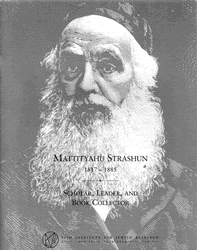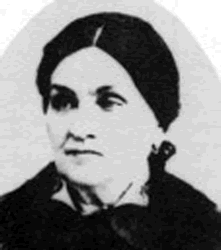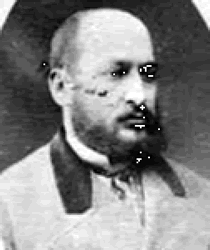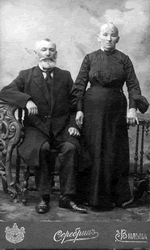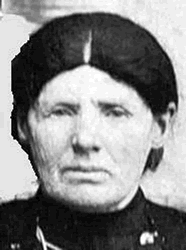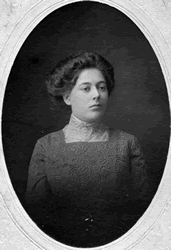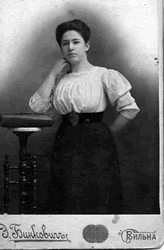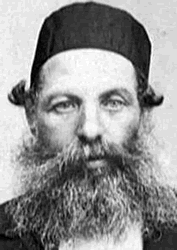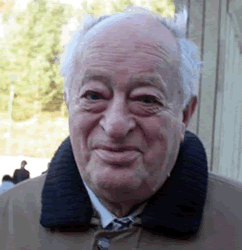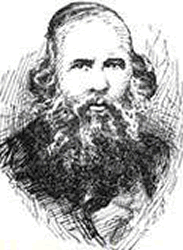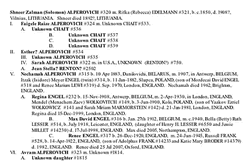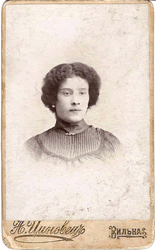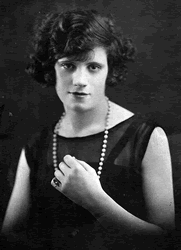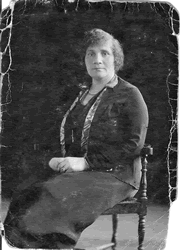Strashun Family
Click
on Photos to Enlarge
#strsn-1:
#strsn-2:
Gita Harkavy Birth; 1840
Daughter of R' Yosef Bezalel Harkavy and Tzerna-Ita Strashun
Wife of Menachem Man Gavriel Romm
Mother of Dr. Rowan (Rubin) Romm; David Romm; Masha Romm Bloch; Jacob
Romm; Sonia (Sofiya) Romm, Eliyahu Romm; Alexander Romm and Chana
Romm.
Sister of Dvora Harkavy Romm; Rachel (Rashil) Harkavy Konigsberg;
(Vladimir) Zeev Wolf Harkavy; Chana Harkavy Goldovsky; Eliyahu Yehuda
Harkavy and 2 others
Half sister of Badana Gorewitz
#strsn-3:
Menachem Man Gavriel Romm (1842- 1910)
Son of Josef Reuven Romm
#strsn-4:
Gitel and Israel Strashun the parents of Solomon ; Sarah Kogon;
Masha ; Etta Rose Millard; Leon and Jacob
#strsn-5
Musia wife of Yankel Strashun
#strsn-6
Sara Kogon nee Strashun
#strsn-7
Rose Millard nee Strashun
#strsn-8
Yankel Strashun
#strsn-9
October 2013; HAPPY 85TH BIRTHDAY TO DR. SHIMON ALPEROVICH (Simonas Alperavi?ius), the inimitably charismatic, Litvak-sharp, ever-witty, inspiringly courageous chair of the Lithuanian Jewish Community from 1992 to early 2013.
A few documents in English translation from recent years at: http://defendinghistory.com/category/shimon-alperovich.
Shimon Alperovich has Vilna Jewish royalty in his blood. He is the great-great grandson of the Vilna scholar and Jewish community leader Shmúel Strashún (1794 - 1872) who was much esteemed among the Christian majority, and is often referred to in Jewish lore as the Rashásh (acronymic from his name). The Rashásh's son, bibliophile Matisyóhu Strashún, became even more famous, as bequeather of the fabled lilbrary that bore his name, after whom a Vilna street was named in 1920.
#strsn-10
#strsn-11:
(Mathias (Mattityahu) Strashun, picture from the Jewish Encyclopedia
Message: My grandmother was from a family that was permitted to live in St.
Petersburg during the czarist time or so I have been told. One of her ancestors
was involved in some capacity with building or financing the Trans-Siberian
Railroad. She was also a Strashun of the Strashun Library in Vilna. Do you know
any resources for me to look at that might help me figure out my family's
connection to the building of the Railroad?
Thanks,
Marilyn Tebor Shaw
Marilyn Tebor Shaw (matshaw1@mac.com) on Thursday, June 12, 2008 at 18:07:32
---------------------------------------------------------------------------
Strashun family;
Samuel ben Joseph Strashun (1794–March 21, 1872) (Hebrew: ????? ??????? ??????), known also as Rashash (??"?) was a Russian Talmudist born in Zaskevich, government of Wilna. He was educated by his father, and became known as a proficient Talmudist. He married at an early age, and settled with his wife's parents in the village of Streszyn, commonly called Strashun (near Wilna), and assumed the latter name. The distillery owned by his father-in-law was wrecked by the invading French army in 1812, and the family removed to Wilna, where Samuel established another distillery and became one of the most prominent members of the community. His wife conducted the business, as was usual in Wilna, and he devoted the greater part of his time to studying the Talmud and to teaching, gratuitously, the disciples who gathered about him. The Talmud lectures which for many years he delivered daily at the synagogue on Poplaves street were well attended, and from the discussions held there resulted his annotations, which are now incorporated in every recent edition of the Babylonian Talmud (Hagahot v'Chiddushei HaRashash). His fame as a rabbinical scholar spread throughout Russia, and he conducted a correspondence with several well-known rabbis.
Strashun was offered the rabbinate of Suwalki, but he refused it, preferring to retain his independence. His piety did not prevent him from sympathizing with the progressive element in Russian Jewry, and he was one of the few Orthodox leaders who accepted in good faith the decree of the government that only graduates of the rabbinical schools of Wilna and Jitomir should be elected as rabbis. He wrote good modern Hebrew, spoke the Polish language fluently, was conspicuously kind and benevolent, and was highly esteemed even among the Christian inhabitants of Wilna. Besides the above-mentioned annotations, he wrote others to the Midrash Rabbot, which first appeared in the Wilna editions of 1843-45 and 1855. Some of his novellæ, emendations, etc., were incorporated in the works of other authorities. He died in Wilna on March 21, 1872.
Mattityahu, son of Rabbi Samuel Strashun was born in 1817 and passed away in 1886. He had a brother: Eliyahu.
Mattityahu' books and house were bequeathed to the Vilna Kehilah to become a public library.
Shmuel Strashun (( 1840- 1895) son of Eliezer, brother of Mattityahu, took over the running of the library- after he passed away his son Isaac took over and headed the library for 35 years. ( from Yahadut Lita)
Mattityahu (Mathias) Strashun (1817-1885):
Scholar, Leader and Book Collector
http://www.yivoinstitute.org/exhibits/strashun/strashunlibrary.htm
Introduction
Mattityahu Strashun's Biography
A Brief History of the Strashun Library
The Story of Hebrew Printing
Samuel and Mattityahu Strashun: Between Tradition and Innovation
By Dr. Mordechai Zalkin
Mattityahu Strashun's Biography
Excerpted and translated from Ir Vilna by Hillel Noah Maggid
Steinschneider (Vilna 1900)
Mattityahu, son of Rabbi Samuel Strashun was born on Hoshana Rabbah
Day of the year 578 (1817). Since childhood he showed evidence of
exceptional memory and great talent in the study of Talmud. His father
employed an excellent tutor, Rabbi Yeshaya David of Lebedev,for him
and his older brother Eliyahu. One day the great Gaon, Rabbi Menashe
of Ilya, a relative, visited the Strashun family. All the dignitaries
of Vilna came to meet Rabbi Menashe and hear his Torah learning. Rabbi
Menashe examined young Mattityahu about his studies in the presence of
this large crowd, and he replied correctly and accurately to every
question.
At age sixteen, he started to study science and mathematics on his
own. Soon he began to correspond with several maskilim, such as the
writer Isaac Ber Lebensohn and Samuel Joseph Fuenn, who quoted him in
their articles. Strashun, often writing under a pseudonym, also became
a regular contributor to several scholarly Hebrew periodicals that
began publication in the 1850s.
When he was 14 years old, Mattityahu married Sarah Hanah, daughter of
the wealthy Yosef Eliyahu Eliasberg (1798-1881). The couple had two
daughters, Gita and Itta, who both died at a very young age. With the
help of his father-in-law, Strashun started a business, which was
mostly managed by his wife and her brother. The Russian Census report
of 1851 lists Strashun's capital as at least 8000 rubles.
Strashun's economic success enabled him to purchase thousands of
books, which he read avidly and memorized. His house became a
destination for scholars, who flocked to hear his erudition and to
consult his books. In 1848, he was appointed head of the Burial
Society, whose records were in disarray. Strashun hired someone to
take care of the account books and record the names of the deceased. A
few years later, he became the head of the Charity Committee of the
Vilna Community, Tsedakah Gedolah, which was in charge of all
community affairs. In 1868, he was appointed member of the Vilna
branch of the State Bank, and was honored ten years later for his
exemplary service with a gold medal (17 February 1878). In addition,
he served in the Vilna City Council (Duma). Mattityahu died childless
in December 1885, and his wife died a few months after him.
In his will, Strashun left 5000 rubles to the Tsedakah Gedolah, 1500
to the Old Age Home, 1000 to the Yeshiva in the Butchers' Kloyz, and
500 rubles each to four Talmudic schools. His books and house were
bequeathed to the Vilna Kehilah to become a public library. He also
left an endowment to pay the salaries of a librarian and an assistant.
Following are a few excerpts from the introduction by his nephew and
executor, David Strashun to Likute Shoshanim, Being the catalogue of
books collected by Mathias Strashun of Vilna, published in Berlin,
1889:
[The Title] Likute Shoshanim [Selections of Roses] was chosen by my
late uncle while he was still alive...the numerical value for Likute
Shoshanim is 861; the numerical value of Mattityahu is also 861, as is
the value of Strashun. This is the reason why I called this catalogue
Likute Shoshanim, and this will be the title of all his collected
writings, which, with the help of God we will begin to publish...
[My uncle] strived throughout his life to bring honor to God and to
his people and share with them his learning and his fortune... Such
people are great not only during their lifetime, but also in their
death, when they leave their lifelong legacy and the fruit their
learning to the entire community. These are the heroes whose memory is
a blessing for ever and ever. My uncle, the genius Rabbi Mathias
Strashun was one of these great sages.
A unique man, who had the two-fold privilege of being both a great
Torah scholar and a great communal leader. He chose to leave his great
book collection, comprising of thousands of volumes, full to the brim
with delicious food for mind. In addition, blessed be he who had the
privilege to see the commentaries and annotations to 63 books that he
wrote during his lifetime. His wisdom shines like stars and his memory
and good name will be of glory and blessing forever and ever.
I promised my dear uncle that after his death I would take good care
of his books and see that they serve the entire House of Israel. When
I made my promise, I thought that this would be an easy assignment.
But soon I learned that, in addition to there being difficulties
involved in obtaining a license to open a library, my uncle had left
his library unorganized and uncataloged. It took us many months to
prepare this catalogue. Since cataloging is a skill rather than a
wisdom, the people who did this work asked me not to mention their
names... I pray that my genius uncle's memory will enable us to open
the library as soon as possible...
-------------------------
In the shulhoyf [courtyard] of the Great Synagogue of Vilna stood a
two-story building. The sign on its door read: "The Library of Rabbi
Mattityahu son of Rabbi Samuel Strashun." For forty years before the
Holocaust (1901-1941), this building served as one of the most
important cultural institutions of Jewish Vilna. The library was
established through the generosity of Rabbi Mattityahu Strashun
(1817-1885), a renowned Vilna philanthropist, communal leader,
scholar, and bibliophile. It included many rare Hebrew books and
manuscripts, which Strashun had painstakingly collected over a period
of 50 years, beginning with his bar mitzvah. By the time he died in
1885, the magnificent library had amassed 5739 books and manuscripts.
In his will, Strashun, who was childless, bequeathed his books and his
home to the Vilna Kehilah [Community] and appointed his nephew David
Strashun as the executor. David Strashun hired scholars to catalog
this collection. The catalogue was published in 1889 under the title
Likute Shoshanim [A Gathering of Roses]. In 1892, the Strashun library
was opened to the public in Mattityahu's former home. However, it soon
became clear that the building was too small for its purpose, and, in
1899, the trustees of the library decided to erect a new building
inside the synagogue courtyard. The document authorizing construction
of the new building is displayed in this exhibition.
In 1901, the library moved to its new building in the shulhoyf. The
original Strashun collection of rare books was housed in a special
room, while the main reading room served the general public. The Vilna
Community assumed responsibility for the property in perpetuity. The
Strashun Library immediately became a popular place for study and
leisure reading. The average daily number of readers was more than
200, mostly high school and seminary students, and there was always a
line of readers outside the door. In the evenings the Library served
as a Jewish cultural center.
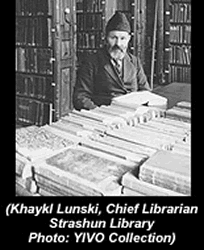
The Library directors were Samuel Strashun and, later, Isaac Strashun.
The chief librarian was Khaykl Lunski, who served in this post until
the demise of the Library under the Nazis in 1941.
The collection continued to grow, primarily through gifts and bequests, since there
was little or no budget for new acquisitions. Beginning in 1928, the
Library received from the Vilna University Library all Hebrew and
Yiddish books published in Poland. In the 1930s, the number of books
was reported to be 35,000.
The Nazis occupied Vilna on June 23, 1941 and, soon thereafter,
ordered the Jews to move into a ghetto. Both the YIVO Library and the
Strashun Library were taken over by the Einsatzstab Rosenberg, a Nazi
task force assigned to systematic looting of Jewish cultural
treasures. The Nazis forced the librarian and a few others to select
and crate hundreds of thousands of Jewish books and archives. The
wooden crates were shipped to Frankfurt-am-Main, where they were
stored in a huge warehouse, waiting to be incorporated into the future
"Library of the Extinct Race." In 1945, the American army discovered
three million Jewish books in the Offenbach warehouse, among them
25,000 books from the Strashun Library collection and 15,000 books
from the YIVO Library collection. These volumes were rescued from the
ruins of Europe and brought back to YIVO in New York in 1947.
In the 1970s, the YIVO Library hired the well-known bibliographer,
Rabbi Chaim Lieberman, to catalog the rabbinical portion of the
Strashun collection, while the secular portion remained to be done. In
early 1999 YIVO moved to its new home at the Center for Jewish
history. Later that year it received a generous grant form the
descendants of Mattityahu Strashun in the United States, that enabled
the YIVO Library staff to computerize Lieberman's catalog cards, as
well as catalog the books which were never cataloged before. We are
very pleased to offer greater access to this important historical
collection and to display some of its treasures for the first time.
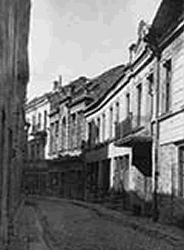
Strashun Street
One of the joys of having records translated under the auspices of the
Litvak SIG or JewishGen is that all sorts of unexpected hidden treasures
emerge.
An example is a marriage record from Panevezys. The bride Khaia Strashun
from Vilnius is the great niece of Mattityahu Strashun, the founder of the
Strashun Library in Vilnius. Her father David Strashun was the executor of
his uncle's will who made sure that the 5,739 books and manuscripts had a
permanent public home.
Who would have thought to search for her marriage record in Panevezys since
she was resident in Vilnius? Not only that, her groom, a widower, was
originally from Prussia. Evidently, the groom, Kopel Mikhaelis, was living
in Panevezys, but how and why they came to be married in Panevezys would
probably make a good tale.
This type of find is an example of what can come out of supporting the
translation efforts which have been underway for some time on not only
Panevezys, but many other shtetls as well. It is well-worth the effort.
Ann Rabinowitz
Hi Eilat,
I have seen your name on JewishGen but don;t remember if we have been
in touch before.
I found Andi's article about the Alperovich family and I wrote to her
because of the names. My late husband was Shneur Zalman, named for
his grandfather Shneur Zalman Alperovich. Family lore says that he
was a descendant of Shneur Zalman of Lyady.
Today I found your website and saw the name Strashun. My late
husband's grandmother was Nechamah Engel (nee Alperovich - daughter of
Shneur Zalman Alperovich) and she went from Lithuania with the
Strashun family to Antwerp acting as a 'nanny'. Her sisters went to
Philadelphia but as I am not sure of their first names I have never
been able to trace them. However because of the connection between
Alperovich and Strashun the family tree I have must join with yours at
some point. Nechamah married in Antwerp and went with her husband to
England. My late husband and I were both born in England.
I attach pictures of the Alperovich family and wondered if you could
see any family resemblances. The young woman on the left, Jean, was
born to one of the Alperovich sisters in Philadelphia and the woman on
the right is presumably her mother. I also attach a tree showing what
I have managed to piece together about the Alperovich family but I
think the sisters' names are not correct. The only names of which I
am certain are Faigle Raize, Nechama and Abram who supposedly remained
in Lithuania.
Do you have any Philadelphia connections? How are you connected to
the Strashun family?
Kind regards,
Judy Wolkovitch
